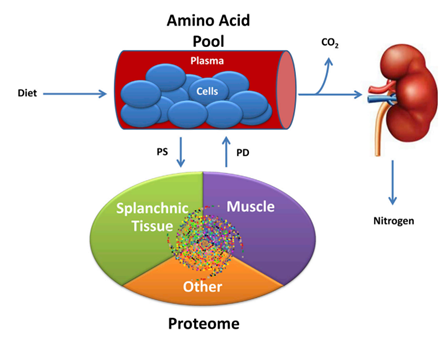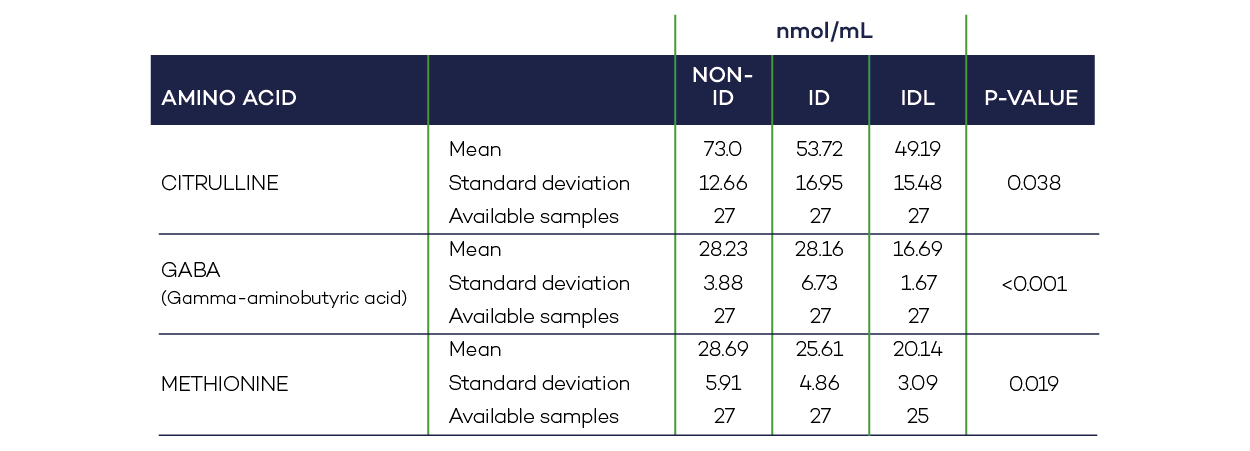
Can amino acid supplementation support horses prone to laminitis?
- Home
- Can amino acid supplementation support horses prone to laminitis?

With spring just around the corner, many horse owners will be starting to worry about their horses developing laminitis. Laminitis is a painful condition of the hoof where the laminae in the hoof capsule, which sit between the hoof wall and pedal bone, becomes damaged. There are many causes of laminitis, one of which is hyperinsulinemia. Hyperinsulinemia (also known as insulin dysregulation, ID) is commonly associated with horses who have endocrinological diseases such as EMS.
A 2022 study carried out by Stockle et al in Germany investigated the resting amino acid concentration of plasma in 25 horses deemed to be at risk of hyperinsulinemia. This article aims to summarise this paper and investigate how the findings can be used to support insulin dysregulated horses at risk of developing laminitis.
The role of insulin in glucose metabolism is well known, resulting in the starch and sugar content of equine diets being strictly monitored. However, the role of this hormone on protein metabolism is often left out of the insulin dysregulation equation.
In addition to playing a role in the breakdown of dietary protein (Biolo and Wolfe, 1993), insulin also plays a role in protein synthesis by stimulating an anabolic environment which initiates signalling pathways within the cell. When insulin is dysregulated, the signalling pathways are also disrupted, compromising protein synthesis as amino acids are not taken into the cells from circulation (Loos, 2018). However, if amino acid levels are high enough, there can be a net gain in protein synthesis due to the inhibition of protein breakdown (Vargas et al 2022). Figure 1 below shows a high-level view of this process.
Figure 1: Simplified whole-body model of proteostasis amino acids distributed through cellular compartments and the bloodstream
 The proteostasis amino acids travel via blood vessels to different tissues, where they may be incorporated into proteins via protein synthesis (PS). Alternatively, they may be broken down (protein degradation - PD) and released back into the amino acid pool where they may be recycled via acylation to tRNA for further PS. The amino acids that are not used in protein synthesis are oxidized, releasing carbon dioxide and nitrogen, and are excreted in the urine via kidneys (James et al, 2017).
The proteostasis amino acids travel via blood vessels to different tissues, where they may be incorporated into proteins via protein synthesis (PS). Alternatively, they may be broken down (protein degradation - PD) and released back into the amino acid pool where they may be recycled via acylation to tRNA for further PS. The amino acids that are not used in protein synthesis are oxidized, releasing carbon dioxide and nitrogen, and are excreted in the urine via kidneys (James et al, 2017).
In this 2022 study, 25 obese horses and 2 lean horses (who had history of laminitis) underwent combined glucose insulin testing (CGIT) and radiography to determine which of the following categories the horses fell into: not insulin dysregulated and not laminitic (n=5), insulin dysregulated and not laminitic (n=14) or insulin dysregulated and laminitic (n=8). There were no horses who were laminitic but not ID.
All horses were fed a hay only diet, with the exception of one horse who also received a mineral supplement and one who received pergolides (veterinary medicine). Following the study, 3 other horses used for the experiment were diagnosed with PPID (pituitary pars intermedia dysfunction/Cushings). The authors understand this may have affected amino acid concentrations.
Of the 16 amino acids included in the study, 3 were found to be statistically significantly different between non- ID horses and ID horses with or without laminitis. These three were: citrulline – lower in non-ID horses than those with ID, GABA – (gamma-aminobutyric acid) and methionine, both of which were higher in non-ID horses than those with insulin dysregulation (ID) and laminitis (IDL). Table 1 below shows these results. For all results, please see table 2 in annex I.

Methionine, an essential amino acid and third limiting amino acid, is probably the most well known of the three amino acids found to be different in this study. Methionine is commonly used in hoof support supplements due to its sulphur content and the role it plays in keratin formation. Methionine and cystine also have roles to play in glutathione metabolism – a major antioxidant formed within the body to prevent damage from oxidative stress.
Normally, horses would have access to adequate methionine through grass (both fresh and preserved). However soaking forages to remove as much water-soluble carbohydrate (WSC) as possible is common practice in the UK when feeding metabolically challenged horses. In doing so, many other nutrients such as proteins and, therefore, amino acids are lost. Alfalfa hay has a similar methionine value to grass hay but with a slightly lower sugar content, so perhaps could be an appropriate alternative in the equine diet. Reducing grazing time, or replacing grass with lower energy alternatives such as straw, are also common practices to reduce WSC from entering the equine diet, which in turn reduceS levels of methionine being consumed.
Synthetic methionine is also available for use in both GB and EU as an additive in the forms of DL and L methionine. Both the natural and synthetic sources are readily available and cost effective. Taking the importance of methionine into account and the results of this study, it may be advantageous to supplement diets of horses at risk of laminitis with this amino acid.
GABA is a non-proteogenic amino acid (is not used to create proteins), primarily acting as an inhibitory neurotransmitter in mammalian tissues. In one study however, it was found to accelerate wound healing. Furthermore, in humans, GABA is thought to have a role to play in skin elasticity and collagen expression. With this in mind, and the degradation of the laminae during laminitis, the authors of the study (Stockle et al., 2022) hypothesised that GABA could play a role in the healing aspect of laminitis. This could be part of the reason why horses who have had laminitis once are often more likely to have recurring episodes. GABA manipulation should be done with caution however as it is a banned substance on the FEI Clean Sport Prohibited Substances Database (FEI, 2024).
Citrulline, like GABA is also non proteogenic and its main role in the body is to act as an intermediate metabolite in ureagenesis. However, citrulline is also metabolised into arginine in the kidneys (Lau et al., 2000). Arginine plays a major role in vasodilation and nitrogen oxide (NO) metabolism; NO metabolism and GLUT 4 translocation is stimulated by insulin receptors (Kim et al., 2006). Stockle et al hypothesised that this pathway may be damaged in ID horses, resulting in vasoconstriction. Vasoconstriction of lamellar tissues can cause severe laminitis (Peasebrook Equine Clinic, 2024). However, as shown in Table 2, the differences in levels of arginine were found to be statistically insignificant between ID and non-ID horses and so arginine supplementation to increase vasodilation may not work in insulin dysregulated horses - although we note it was a small sample size of non- ID horses.
In a 2018 study comparing plasma amino acid concentrations of horses with Equine Metabolic Syndrome (EMS) and healthy horses following a high protein meal, it was found that the EMS horses had lower levels of aspartate, glutamate, asparagine and plasma urea nitrogen in comparison to healthy controls (Loos, 2018). It was also reported at the time that the EMS horses had a 9-fold increase in plasma insulin levels.
These findings are interesting on two levels; the different amino acids found in the plasma and the use of horses with EMS. As previously mentioned, three of the horses in the 2022 study were later diagnosed with PPID. Perhaps one of the next steps in this line of research would be to compare amino acid levels in horses with different insulin dysregulation linked diseases?
In a 2019 study; Loos et al., concluded that high protein meals (2x1kg meals of a 31% crude protein pellet) fed to EMS horses exacerbated hyperinsulinemia and that the protein levels in the diets of ID horses should also be controlled. With this information in mind, supplementing equine diets with targeted synthetic amino acids may be the middle ground between stabilising amino acid levels in plasma without affecting insulin secretion.
There is a lot more work to be done on investigating the role insulin has across the whole equine body and how we can best support horses with insulin dysregulation within regulatory frameworks. Methionine is an important amino acid for many reasons and can be easily added to the equine diet to support horses susceptible to laminitis. Methionine has been a commonly used nutrient in hoof support supplements for many years and this new research could add another benefit its inclusion.
For the full article, including Annexe, please download here.
If you would like any assistance with amino acids and diet formulation, please contact our Equine team on:
Clare McCafferty - clare.mccafferty@premiernutrition.co.uk
Kayleigh Manthorpe - kayleigh.manthorpe@premiernutrition.co.uk
Kate Robinson - kate.robinson@premiernutrition.co.uk